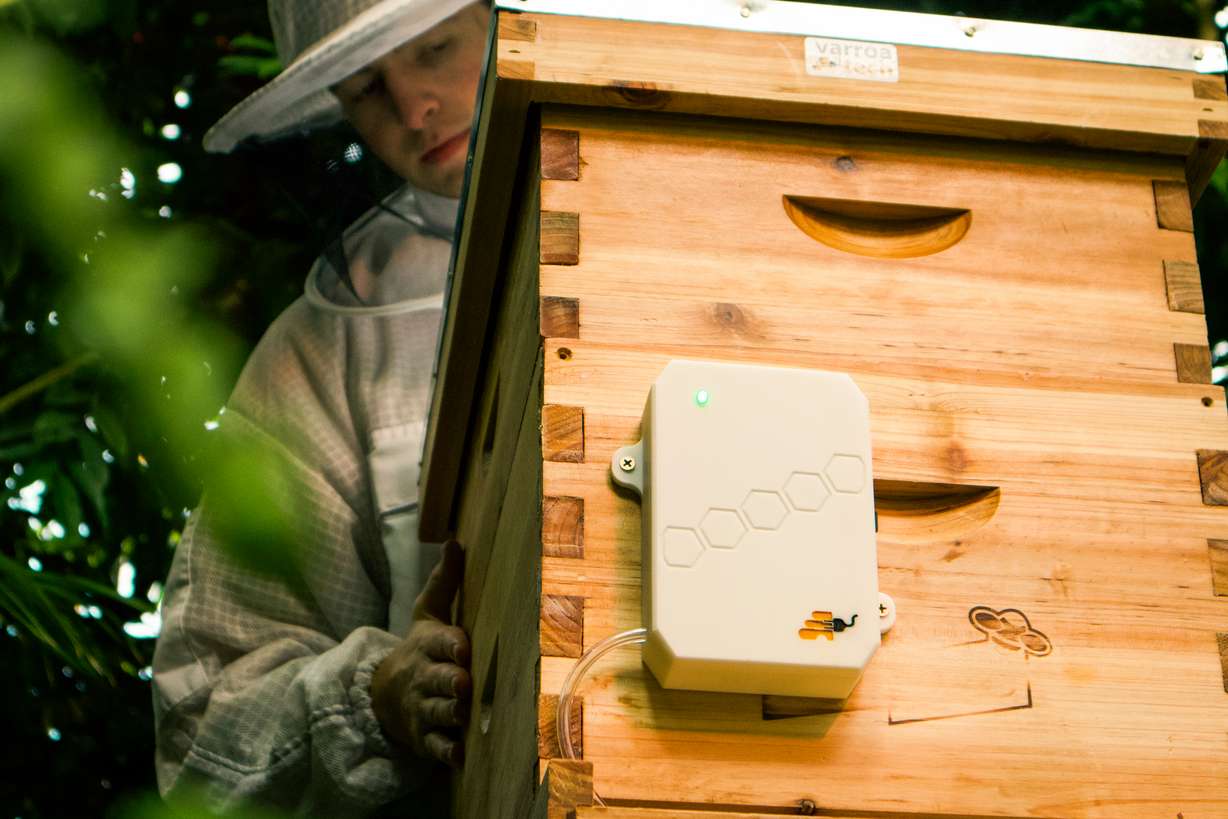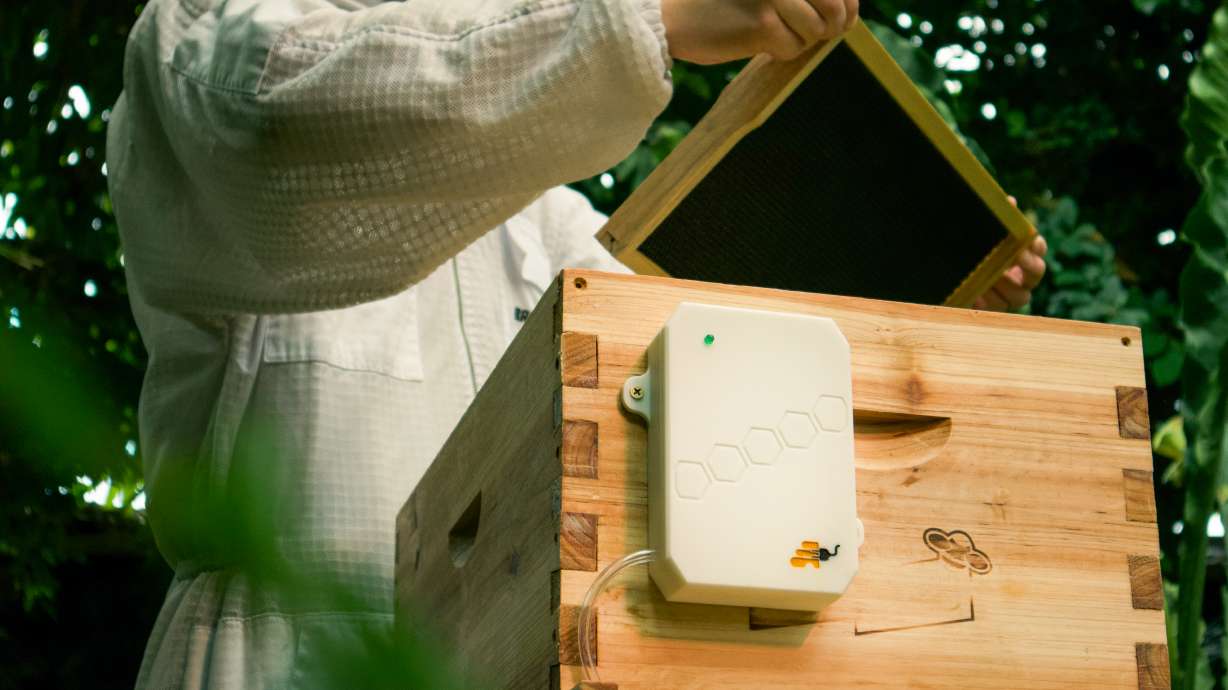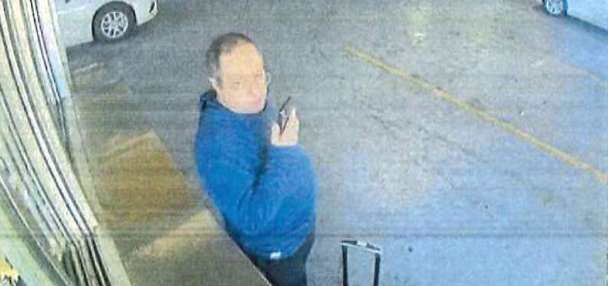Estimated read time: 4-5 minutes
- BYU students developed a device to detect varroa mites in beehives.
- The invention won BYU's Student Innovator of the Year competition.
- The device aims to reduce bee deaths, boosting pollinator populations and food production.
PROVO — One of the greatest risks to the health of beehives and pollinators is varroa mites, but a new invention from BYU students is aiming to prevent the deadly impacts of the mites.
Varroa Tech, a team of eight BYU students, won BYU's Student Innovator of the Year competition last week with its beehive parasite detector.
The team met through the Crocker Innovation Fellowship, which is a yearlong program that brings together students of all backgrounds and majors to tackle real-world problems.
The Varroa team started looking into beehives because one of the members' uncles is a beekeeper. The team learned 40% to 50% of beehives die due to parasitic infestations of varroa destructor mites.
"There's really not a great solution for it. It's terrible and a huge underserved market. This might be above our pay grade, but we will look into it," Varroa Tech member Tyler Lenning said. Lenning is an environmental science and sustainability major.
Veteran beekeepers can usually smell when a beehive is infected, and there are some methods to cleanse a hive of the infection. But it's difficult to know when the infestation is past the point of no return.
These infestations lead to the deaths of entire hives, decreasing the number of bees and pollinators, which directly impacts the produce available.

So the students set out to create a product to reduce beehive deaths from the infestations. The team spoke with researchers from the University of Poland who had studied parasites in beehives and used their research as the basis for their invention.
The Varroa Tech device is a boxlike structure that can be attached to a beehive. A clear air hose is inserted in the hive and pulls in the natural fumes to analyze.
Real-time data is then sent to an app for interpretation to warn keepers of issues arising in the hive, measure other health indicators, and, most importantly, track the level of mite infestation.
"The mites are able to infest a hive and basically take down a whole hive with only 3% to 4% infestation level. So it's super important for beekeepers to know the level or percentage of mites in the beehive and when, so they know when to treat (the hive)," information systems graduate Devon Wolsleger said.
An impact larger than bees
Modern agriculture relies on bees to pollinate, Lenning said, and Varroa's goal is to help prevent and reduce bee deaths. If their device can halve the 40% of beehives dying, then there will be about 20% more pollinators around to help produce greater amounts of food products, he added.
"It's more than just beekeepers. All the food we eat, or at least most of it, comes from bees in one way or another," Lenning said. "If we can provide for our pollinator communities in some way and increase their likelihood of survival, with less people having to touch boxes and spray harsh chemicals on bees, then all the better. And that's what ours does."

Wolsleger said he's been grateful to contribute to a project that helps save bees' lives, increase the number of pollinators and potentially put more food on people's tables.
"It's so cool to be able to feel like we might be able to contribute to more produce selections at a cheaper price. It's a global problem, and anyone who eats any produce is affected by it," Wolsleger said.
The Varroa team had been working on the product for almost a year for its fellowship, building prototypes, testing equipment and making adjustments. In November, the team started prepping for the Student Innovator of the Year competition.
After many late nights working, presentation slide-polishing, and speech-practicing with spouses later, the team took to the stage on Feb. 27 to present the invention. The seven finalist teams were judged on aspects of engineering, innovation and the impact of their products to determine the winner.
Wolsleger said he was so nervous he almost couldn't believe it once his team was announced as the winner, but he was so excited. Lenning said it feels great the team accomplished what it set out to do after spending months hoping and working for the win.

In total, the team has received $14,500 for winning the competition and being picked as a crowd favorite. The team has the potential to win another $4,000 if it gets picked for the social impact award that will be announced next week.
"The goal is we want to put all the money towards prototyping, testing, just getting this to where it can be sold to beekeepers and they can start saving the bees and helping have more pollinators around," Wolsleger said.
Competitions like Student Innovator of the Year help push students to apply their learning to real-world problems.
"To be able to say 'Hey, I've been learning this, I'm going to put it into a product' and 'Oh, wow, this product can be more than just a school project. It can be something that actually helps people and saves bees' lives and produces more good in the world.' I think that is so fascinating," Wolsleger said.
Lenning agreed, saying the competition epitomizes BYU's motto: "Enter to learn. Go forth to serve."
"If you're not using your education to help people in the real world, what good is your education?" he said.










